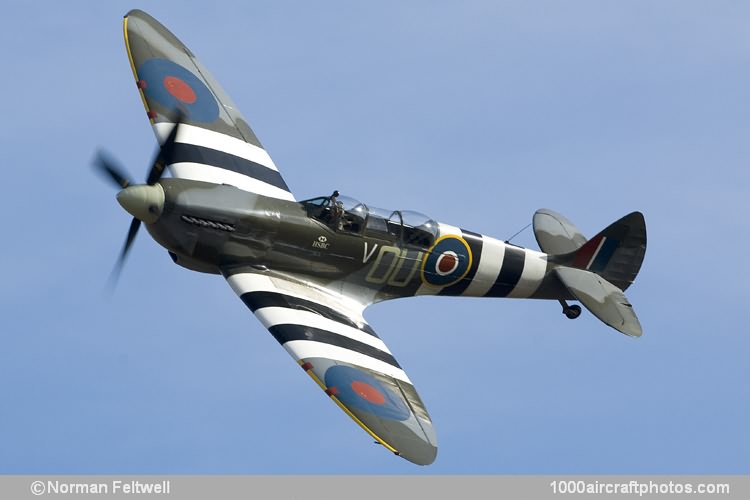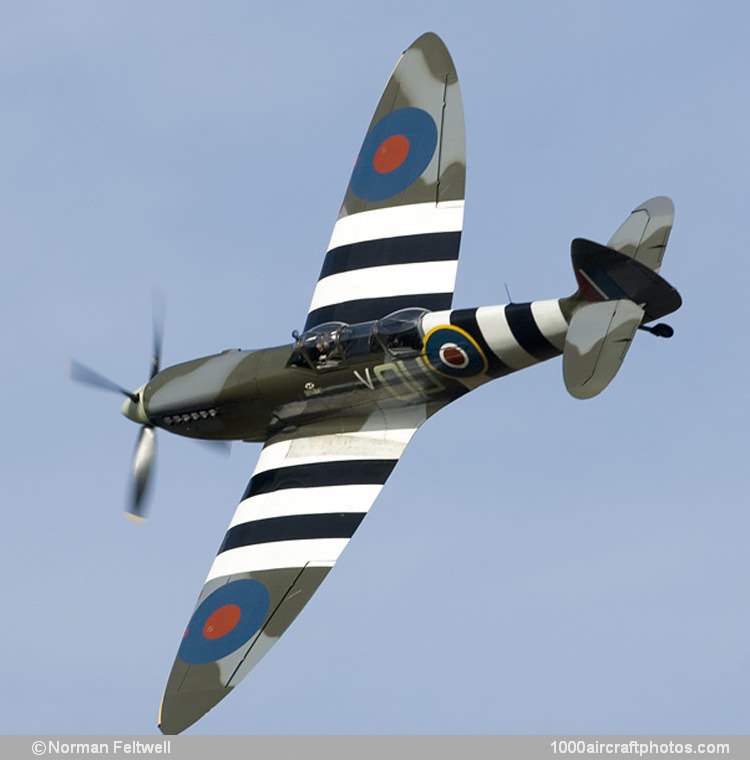06/30/2011. Remarks by Johan Visschedijk: "While Supermarine was engaged in evolving the Spitfires Mk.VII and Mk.VIII to use the new two-stage, two-speed supercharged Rolls-Royce Merlin 60 series engine, advantage was taken of this improved power plant to mate it with a Mk.VC airframe and thus introduce an enhanced-performance Spitfire in a shorter timescale. The result was the interim Spitfire Mk.IX, two Merlin 61-powered Mk.VC airframes serving as prototypes early in 1942, and demonstrating a 10,000 ft (3, 050 m) gain in fighting altitude and a 70 mph (113 kmh) increase in maximum speed.
Production of the Mk.IX totaled 5,656 aircraft (plus 282 Mk.V conversions), service introduction commencing in July 1942. Differing altitude ratings distinguished the Merlin variants used in the LF.Mk.IX (Merlin 66), F.Mk.IX (Merlin 61 or 63) and HF.Mk.IX (Merlin 70). Some Mk.IXs were flown with clipped wings and later modifications introduced (not simultaneously) a broad-chord rudder with pointed tip, a cut-down rear fuselage with all-round vision canopy, extra fuel, bomb racks and a tropical carburetor filter.
Similar to the Spitfire Mk.IX, the LF.Mk.XVI was powered by a US-built Packard Merlin 266, and 1,054 were delivered from October 1944, most having the clipped wings. Like the Mk.IXs, later Spitfire LF.Mk.XVIs had the new rudder, cut-down rear fuselage, and, in 1945, an "E" wing armament of two 0.787 in (20 mm) cannon in the outer bays and two 0.50 in (12.7 mm) machine guns in the inner bays.
The pictured aircraft was one of the last of a batch of 2,190 Mk.V and Mk.IX aircraft ordered in the serial range MH298 to ML428 under contract 981689/39 of May 28, 1942. They were produced at Castle Bromwich, Birmingham, between July 1, 1943, and April 29, 1944, the latter date being the date G-LFIX was delivered to No. 485 New Zealand Squadron as a single-seat LF.Mk.IXC under serial ML407.
After it completed 137 missions it was transferred to No. 341 (Free French) Squadron, then No. 308 (Polish) Squadron, then No. 349 (Belgium) Squadron. In February 1945 ML407 returned to No. 485 Squadron, before being sent to No. 345 Squadron (Free French). In April 1945, ML407 moved on to No. 332 (Norwegian) Squadron. At the end of the hostilities the aircraft logged over 200 combat flying hours in 176 missions.
In 1950 the aircraft was returned to the manufacturer, and was converted into the two-seat T.Mk.IX trainer and with the serial IAC162 it served with the Irish Air Corps until its retirement in 1960. It appeared in the movie 'The Battle of Britain' and subsequently it was acquired by the Strathallan Museum, where it was stored disassembled.
In 1979 it was sold to Nick Grace who restored the aircraft to airworthiness and registered G-LFIX (the four characters referring to the aircraft original mark) Grace flew the aircraft on April 16, 1985. Grace was killed in a car crash in 1988, but his widow, Carolyn Grace (already a pilot) soloed on G-LFIX in 1990 and has flown the aircraft ever since. The aircraft is also flown by her son Richard.

